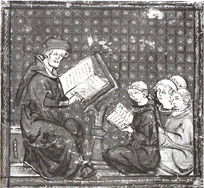Most people were peasants and never learned how to read or write. Boys and girls learned by watching their parents. Boys learned from their father to farm and use tools. Girls learned to weave, sew, and cook from their mothers. Some children were sent to monasteries or abbeys where they became monks or nuns. Some of the luckier children were sent to a songschool. These were run by the Christian Church, which needed boys to sing in the choir. Church services were spoken in Latin, so in order to read the hymnals, these boys learned to read Latin. Some parents sent their boys and girls to songschools, even if they didn�t sing in the choir. Children of noble families were sent to live in the castle of an aunt or uncle. Boys would go as pages to learn manners and wait tables. Girls learned how to do needlework, how to spin, and how to manage a household.

Once educated students were about fourteen years old, they attended universities. They studied subjects such as writing, speaking, logic, geometry, arithmetic, astronomy, and music. After ten years of studies, these students might become doctors or priests. These students were referred to as scholastics because they were well rounded in "faith and reason."
FONT>
